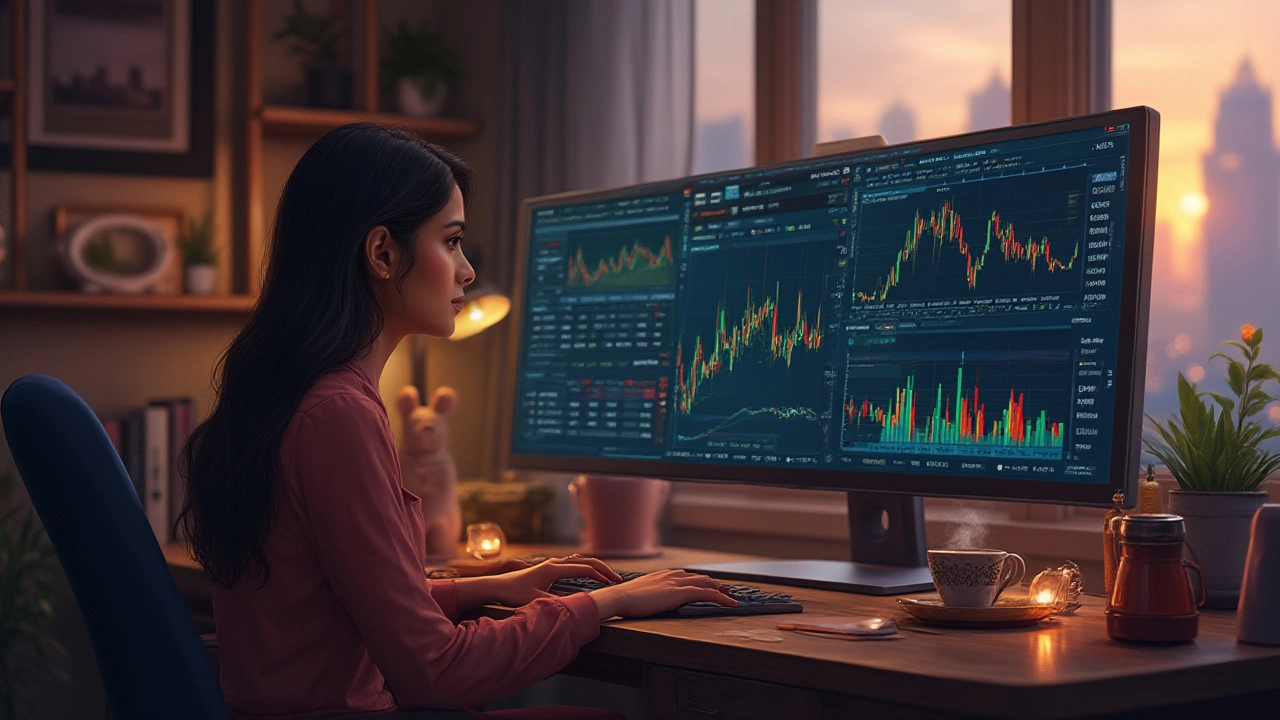Is India Good for Trading? Exploring Opportunities in the Indian Market

Imagine a market where millions of trades happen every single second, where youthful energy and digital innovation collide, and where a single TikTok video can make company shares jump. Welcome to India’s trading scene. If you’re wondering whether India is a good place for trading—stocks, forex, or commodities—you’re not alone. Tons of investors, from the guy in a tiny Himalayan village using his phone, to the hedge fund whales in Mumbai’s office towers, all dive into India’s markets. But what actually makes India tick for trading? Why does the Indian market capture so much attention right now—and is it as open and lucrative as people think? Let’s strip the myths away and look at what you need to know in 2025.
What Makes India’s Trading Scene Unique?
India isn’t just the world’s most populous country—it’s also one of the fastest growing economies, sporting a young population with a median age of under 30. This youthful energy fuels trading, especially online. Over 110 million demat accounts (think of these as trading IDs) were registered in India by mid-2025, up from just 40 million in 2020. Every minute, thousands of new retail traders are joining the action, attracted by the low entry barriers and a spread of zero-brokerage apps like Zerodha, Groww, and Upstox. Why so much excitement? Accessibility plays a part: nearly everyone has a smartphone, and digital payments are easy—even in small towns.
But there’s more to it than numbers. India’s stock market, the National Stock Exchange (NSE), regularly ranks in the top five globally by volume. Companies like Reliance Industries, Tata Consultancy Services, and Infosys—which are household names in India—have market capitalizations that compete with giants in Europe. Indian equity markets have shown strong returns, with the Nifty 50 index gaining about 14% (CAGR) over the last decade, outperforming several developed markets like Germany or the UK.
And it's not just locals getting involved. Since early 2023, foreign institutional investors (FIIs) increased their net investments in Indian equities, putting in over $28 billion through the end of 2024. The reason is simple: India’s economy has been growing at around 7% per year, beating most major economies. This brings opportunity for traders, both long-term investors and short-term day traders who thrive on volatility.
But trading in India comes with its quirks. Daily price movement in Indian stocks is often wild—a routine day might see blue-chip stocks swing over 5%. There are circuit breakers (automatic trading halts) to keep things sane, but volatility is baked into the market DNA. Also, government regulations keep evolving. For instance, the Securities and Exchange Board of India (SEBI) pushed for stricter margin requirements in recent years, so leverage is lower than in the wild-west days before 2020.
Foreign traders face restrictions, too: while stocks and index futures are fair game, the Indian forex market is heavily regulated. Only certain currency pairs—INR paired with USD, EUR, GBP, JPY—are actively traded on Indian exchanges. Offshore forex trading is technically illegal for residents. So if you dream of trading the South African Rand from Mumbai, it’s not happening—at least not legally.
This mix of digital growth, youth participation, foreign interest, and dynamic rules truly sets India’s trading scene apart from anywhere else. Here’s a quick snapshot to put numbers into perspective:
| Fact | India (2025) | USA (2025) |
|---|---|---|
| Number of Retail Trading Accounts | 110 million+ | 120 million+ |
| Average Daily Equity Turnover | $18 billion | $72 billion |
| Median Age of Population | 28.4 years | 38.5 years |
| Annual GDP Growth (2024) | 7.2% | 2.1% |
| Popular Trading App | Zerodha | Robinhood |
| Primary Regulator | SEBI | SEC |
Opportunities and Hot Sectors to Watch
If you want to trade in India, it helps to know where the action is. Certain sectors are obvious magnets. Technology companies, for example, keep clocking impressive growth. As of 2025, TCS, Infosys, and HCL are powerhouses, driven by a global tech outsourcing boom. The auto sector, especially electric vehicles (EV), is also flying high. Tata Motors and Mahindra & Mahindra are now among the top global EV players. There’s a renewed push for manufacturing, thanks to the Modi government’s "Make in India" initiative. This means infrastructure, construction, defense, and energy (especially renewables) have roaring demand.
Banking and financial services also make up around 35% of the NSE’s total market capitalization. Private banks—think HDFC Bank, ICICI Bank—are riding a wave of consumer lending for homes, cars, and gadgets. The rise of digital payment platforms, like Paytm and PhonePe, adds a whole new layer to financial sector trading opportunities.
For commodity traders, India packs a punch with gold, silver, and agricultural products. The Multi Commodity Exchange (MCX) in Mumbai is one of the world’s busiest for gold contracts. Gold trading is a national obsession—Indians buy nearly 800 tons of gold every year, not just for jewelry, but for investment, too. Monsoon rains can make or break sugar and wheat prices, so market watchers keep one eye on the sky during June-September.
Don’t overlook small and mid-cap stocks either. During 2023-2025, many retail investors watched these stocks outperform big names, sometimes doubling in value within a year. But here’s the kicker: small caps carry bigger risks. Liquidity can vanish faster than a street food cart at the first sign of rain.
Where else are eyes glued? The IPO scene is red hot. Startups in fintech, edtech, and logistics have gone public at a record pace. Zomato, Nykaa, and Mamaearth’s launches made headlines worldwide. High-profile listings can create wild, short-term surges—great for short-term traders able to ride the waves, not so great for folks with slow reactions.
- Retail traders dominate by volume but smart money watches blue-chips and IPOs.
- Keep up with India’s Corporate Action Calendar—bonus shares, splits, or dividends often cause overnight spikes.
- Check which sectors are getting government incentives: semiconductors and green tech are big in 2025.
Finally, don’t sleep on government bonds. G-Secs offer better rates now than bank deposits, and you can trade them directly through your broker. While they don’t make headlines, bonds provide safer returns when equity markets look too wild for comfort.

The Nitty-Gritty: What You Need to Start Trading in India
So how do you actually join the hundreds of millions chasing daily profits? First, you need a demat account, which acts as your digital wallet for stocks. Opening one isn’t hard—apps like Zerodha, Upstox, and Angel One let you submit ID and address proof in minutes. Most brokers offer free account openings and waive annual fees for the first year to attract newbies. You’ll need a PAN card (mandatory tax ID), and if you’re a non-resident Indian (NRI), extra paperwork applies. Foreigners can only trade stocks through special investment routes, so double-check the current SEBI regulations before you try logging in from London or Dubai.
Here’s what a typical process looks like:
- Register with a SEBI-approved broker. Mobile apps are simplest, but you can use their websites too.
- Verify your KYC (Know Your Customer) by uploading your PAN, Aadhaar (national ID), a selfie, and a bank statement.
- Add money via UPI, net banking, or cards. Indian systems like UPI have made transactions almost instant, 24/7.
- Watch the NSE or BSE live, and start trading stocks, ETFs, or derivatives.
- If you want to trade currencies, stick to the licensed INR pairs, and notice the trading hours (9 am to 5 pm IST).
- For commodities, use an MCX-registered account—handy for trading gold, silver, copper, and even crude oil contracts.
Taxation is the next thing on most traders’ minds. Any profit you make from trading is taxable in India. Short-term capital gains (for assets held less than a year) on listed shares are taxed at 15%. If you hold for more than a year, it drops to 10% for gains above ₹1 lakh. Forex and commodity trading profits count as "business income" and come with their own reporting rules. Tax filers: don’t skimp on the paperwork. The tax department is wired into banks and brokers, and audits are lightning fast compared to just five years ago.
Now, if you’re used to trading in the West, Indian markets might feel a tad slow at times. The exchanges take holidays for every major festival—think Diwali, Holi, Eid, and Christmas. Plus, the trading hours (9:15 am – 3:30 pm for the NSE/BSE) might seem short. Pre-market and after-hours trading are still limited compared to the US, though they’re gaining ground.
Be prepared for lots of regulatory messages. SEBI frequently issues guidelines to protect retail investors, sometimes capping daily trading volumes, other times suspending questionable micro-cap stocks. So always read broker notifications. And if you bump into wild social media stock tips, remember: SEBI cracks down hard on pump-and-dump schemes. If tips sound too good to be true, they probably are.
Risks, Realities, and Smart Trading Tips for 2025
No market is a gold mine for everyone, and India is no exception. The very speed and volume that attract traders can also wipe out portfolios in days. Day-to-day moves can be unpredictable. For instance, sudden government policy changes—like an unexpected tax on tech services or import duties on electric vehicles—have triggered 5-8% index slides overnight in recent years. And as recently as February 2025, a single rumor about changes in agricultural subsidies sent sugar and wheat stocks tumbling, while tractor makers saw a burst of buying.
Liquidity dries up fast in small-caps during sell-offs, and circuit breakers—while intended to curb panic—can leave traders locked out, unable to exit losing positions. That’s why savvy traders keep a close eye on news, regulations, and market depth. Diversification isn’t just smart here—it’s mandatory if you want a shot at long-term gains.
Here are a few lessons that ring true for anyone stepping into Indian trading for the first time in 2025:
- Start small. Test your strategy with a modest stake before jumping big.
- Embrace volatility but use stop losses—broker apps make it easy to set these up.
- Don’t ignore company fundamentals. Hype alone can’t keep prices afloat forever.
- Stay updated. Follow SEBI’s circulars, RBI policies, and the corporate action schedules religiously.
- Confused by taxes? File early or use trusted platforms like ClearTax or TaxBuddy to avoid mistakes.
- Watch currency risk if you invest in foreign-linked companies—a weak rupee can hurt even strong performers.
- Don’t trust celebrity tips or WhatsApp groups, where scams are rampant. SEBI fined celebs and influencers millions in 2024 for shady endorsements.
One more heads-up: India's markets tend to move in packs, a behavior known as “herding.” When hot money chases a sector—like EVs or fintech—prices skyrocket, and then deflate just as quickly when the mood shifts. This makes technical analysis important, but not foolproof. Traders who combine charts with news, sector data, and a sense of market psychology do best.
So, is India good for trading? If you thrive on energy, enjoy researching news, and can handle sharp swings, there aren’t many places as lively. Opportunity exists—so do risks. More people are joining the India trading revolution every day, but the smart ones learn the ropes before jumping in headfirst. The secret sauce? Mix a little data with a lot of discipline, keep your ears open, and have fun along the way. If you play your cards right, India's markets can be as rewarding as they are wild.

Post-Comment